By Keith Rittmaster – August 1, 2022
Bottlenose dolphins (Tursiops truncatus) are a familiar sight along the beaches and estuarine shores of Carteret County, NC. One of these individuals, “Cutty”, is well-known in our long-term study of local dolphins. Initially documented with a young calf in June 1985, she was the first dolphin entered into our dorsal fin photo-ID catalog. Her dorsal fin looks much the same today as it did 37 years ago. Female bottlenose dolphins reach sexual maturity at around age seven which makes her a minimum of 44 years old in 2022. We have photo-documented her in the waters around Beaufort, North Carolina on a total of 107 days, only during the months of April-October.
Bottlenose dolphins are born with smooth dorsal fins that can acquire scars and notches over time. Using dorsal fin photo-identification researchers identify individual dolphins and verify resights based on the acquired fin features. This method continues to teach us about residency patterns, migrations, associations, birth rates, reproduction seasonality, healing of injuries, and mortality. Our best-known dolphins are split into two groups that we refer to as 1) “summer” dolphins predominantly seen in warm water months (May-October), and 2) “winter” dolphins seen primarily in cool-water months (November-April). Cutty is one of our summer dolphins.
On June 23, 2022, we saw Cutty in a nursery group of approx. 24 dolphins in the Newport River. This was exciting because we hadn’t seen her since 2019. The disappointment was when we noticed an entangled calf with her. As of July 26, we have not seen Cutty again. We fear the worst for the fast-growing calf with a line wrapped around the head – a slow, painful death next to Cutty, the presumed mom.
The North Carolina Marine Mammal Stranding Network responds to reports of dead, injured, or entangled marine mammals in NC. Carcasses fresh enough to be thoroughly investigated are evaluated for injury and disease. Of the cases where cause of death can be determined, entanglement is the most frequent. If you see a dead, injured, or entangled marine mammal (cetacean, seal, or manatee) please contact 252-241-5119. For more information, please visit https://bonehenge.org/marine-mammal-stranding-network/.
Thanks to the staff, students, and volunteers from the following organizations whos’ collaborations enhance this work: Bonehenge Whale Center, Cape Lookout National Seashore, Carolina Cay Maritime Foundation, Duke University Marine Lab, Friends of the NC Maritime Museum, Lookout Foundation, Mid-Atlantic Bottlenose Dolphin Catalog, NC Division of Marine Fisheries, NC Maritime Museum, NC State University – Center for Marine Sciences and Technology, NOAA Fisheries – Beaufort Lab, Rachel Carson National Estuarine Research Reserve, and UNC Wilmington.
Photos by Keith Rittmaster under NOAA/NMFS permit.






